
Introduction and intuition for flux and magnetic flux.
- Subject:
- Physical Science
- Physics
- Material Type:
- Lesson
- Provider:
- Khan Academy
- Provider Set:
- Khan Academy
- Author:
- Sal Khan
- Date Added:
- 10/07/2015

Introduction and intuition for flux and magnetic flux.
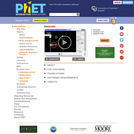
Generate electricity with a bar magnet! Discover the physics behind the phenomena by exploring magnets and how you can use them to make a bulb light.
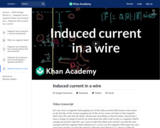
Sal determines the current and EMF induced in a wire pulled through a magnetic field. Created by Sal Khan.
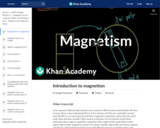
An introduction to magnetism. Created by Sal Khan.

This activity is a classroom lab in which students observe and investigate how magnets interact with each other and the objects around them.
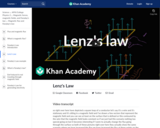
Lenz's Law - seeing that the magnetic field induced by a current induced by a change in magnetic flux (Faraday's Law) counteracts the change in flux.

Explore the properties of magnets by designing a device that can move as far as possible using only magnets to move it, and then design a machine that will stay in motion for the greatest period of time.

This games let you explore magnetic fields. Magnetic fields radiate from the N to the S side of a magnet in a predictable way. By changing the shape of the magnet, these fields change shape.
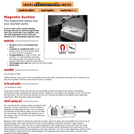
In this activity about electricity and magnetism, learners discover how a doorbell works. A coil of wire with current flowing through it forms an electromagnet that acts similar to a bar magnet. The coil will magnetize an iron nail and attract it in a remarkably vigorous way.

See how a wire carrying a current creates a magnetic field. Created by Sal Khan.

Sal shows how to determine the magnetic force between two currents going in opposite directions. Created by Sal Khan.

Sal shows how to determine the magnetic force between two currents going in the same direction. Created by Sal Khan.

Sal shows how to find the size and direction of the magnetic force using F=qvB and the right hand rule. Created by Sal Khan.
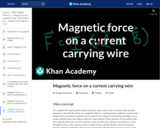
Sal derives the formula F=ILB to determine the force on a current carrying wire. Created by Sal Khan.

Sal does an example problem to determine the size and direction of the magnetic force on a proton moving through a magnetic field. Created by Sal Khan.

Sal determines the radius of the circle traveled by the proton in the previous example by using the formula for centripetal acceleration. Created by Sal Khan.
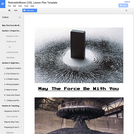
Students need a better understanding of magnetic fields and the ways in which magnets are used to help solve real world problems. Students will explore how magnets work and interact with each other. They will learn engineering skills by designing an electromagnet to lift and transport a Matchbox car from different distances. Students will work with different types of magnets, gauges of wire, nails, and bolts to design their electromagnet.
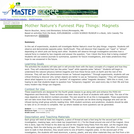
These two activities are just a small part of overall fun students will have in discovering the wonders of magnets and how they apply to us every day.

This lesson will explore the connections between magnetism in natural materials and electromagnetism. The ultimate goal will be for students to form an understanding that the source of magnetism in natural materials is moving charges. It is helpful, but not required, for the students to have some work with electricity, and other distance forces (such as gravity or the electric force). The lesson will probably take two 50-minute periods to complete. Although the video footage is brief, the activities are in depth, inquiry-based, and can take time for the students to explore. The materials are not specifically prescribed, but can include things such as bar magnets, compasses, iron filings, wire, batteries, steel bolts, coils, straws, and hot glue. The activities include drawing the magnetic fields of bar magnets and electromagnets. The activities also include making a magnet from a drinking straw and iron filings.

In this activity, learners create a tiny electric, motorized dancer. Learners use the interactions of magnetism and electric current to make a wire spin, while displaying the Lorentz Force in action. This lesson guide provides one of many ways to build the spinner and links to other methods.